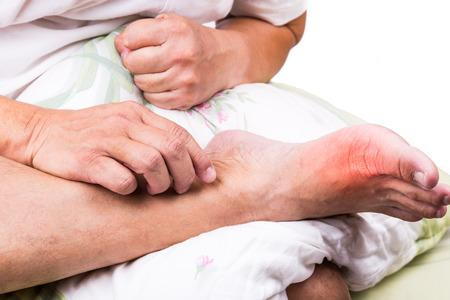Gout can be a very debilitating condition to have. It can affect your daily life and require you to make many changes to your lifestyle. This form of arthritis is caused by a buildup of uric acid in your joints. It commonly affects your feet, especially your big toe joint. However, it can also affect other joints like the ankles and knees as well.

Following several painful bouts of gout, you may notice a pattern to when they arise. Participating in some activities or eating certain foods can put you at higher risk of experiencing a gout attack:
- Eating foods that are high in purines (seafood, alcohols) and other inflammatory foods, such as those with a lot of refined sugar (sugary drinks)
- Drinking excess alcohol
- Not drinking enough water (dehydration)
- Taking certain medications that cause a flare-up as a side effect
- Being sick (including hospitalization, surgery, kidney disease)
- Wearing poorly-fitting and unsupportive shoes (shoes that aggravate the affected joints can trigger an attack)
- Jumping or other high-impact activity, injury (impact or trauma to the affected joint can cause a bout of gout)
You may also learn to recognize the symptoms of an oncoming bout of gout, including but not limited to:
- Feeling: burning, tingling, pain, stiffness, and/or soreness in the joints
- Seeing: redness and swelling
Do your best to avoid increasing the risk of a gout attack. However, if you have indulged a bit, you may want to take steps to reduce your chance of a prolonged and painful attack. This is especially the case for those who experience gout without warning, even being woken up by sudden painful gout attacks.
When you feel a bout of gout about to happen, or if you want to reduce the risk of gout attacks, try some of the following:
- Hydrate! Drink lots and lots of water to assist you in flushing out excess uric acid.
- Exercise! If symptoms have not fully set in, but you feel an attack coming on, you’ll want to keep moving (walk around) in order to promote circulation. It will help you prevent large uric acid buildup. However, if symptoms have set in and you are in pain, it’s best to rest.
- Rest! If you’re already in pain, sit and elevate your feet. An excess strain on painful joints will worsen the gout attack.
- Use ice packs or cold compresses and/or take NSAIDs (non-steroidal anti-inflammatory drugs) to reduce inflammation and pain.
Once you’ve been diagnosed with gout, you should keep up with a healthy lifestyle and diet. Keep up with your medications to reduce your chance of a gout attack. However, if you need additional assistance with foot care for gout, make an appointment at our Crofton, MD office to see our board-certified podiatrist, Dr. Brad Toll. At Crofton Podiatry, we will use the latest treatment options to assess and take care of your foot and ankle care needs. Contact our dedicated team at our Crofton, MD office, which also serves the surrounding areas of Gambrills, Odenton, and Bowie, MD.
